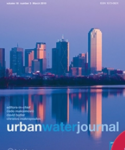Enhancing Escherichia coli removal in stormwater biofilters with a submerged zone: balancing the impact of vegetation, filter media and extended dry weather periods
Abstract
Stormwater biofilters have shown promising yet variable removal of faecal microorganisms. The effects of vegetation, filter media and extended drying on the removal of Escherichia coli are investigated in the current study. Semi-synthetic stormwater was applied to 25 biofilters representing five different design configurations, all of which contained a submerged zone (SZ). The influence of extended dry periods on E. coli removal depended on the presence/absence of vegetation. Uptake of SZ water by plants with extensive roots during the dry periods lead to deterioration of the subsequent outflow water quality compared to unvegetated biofilters. Without a significant loss of SZ volume, a loamy sand biofilter planted with either Carex appressa or Leptospermum continentale can achieve a higher removal performance than an unvegetated washed sand biofilter. However, in warmer climates that experience long dry weather periods, and inability to control SZ volumes, un-vegetated columns may result in lower effluent E. coli concentrations.
